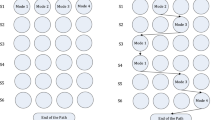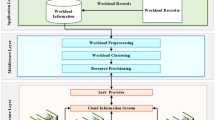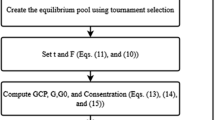Abstract
Cloud computing is an emerging domain that requires more algorithm and techniques for various process. The scheduling process in cloud computing platform needs a good algorithm to schedule the jobs of different users. The main objective of this approach is to develop a scheduling algorithm through iterative algorithm. Here, we use oppositional group search optimization algorithm for iterative process in cloud computing. Initially, we generate a population that contains a group of members and the members consist of the number of users and their respective jobs. The motto of our research is to schedule the user given jobs efficiently. We separate the members from the population based on the fitness function to perform different operations and to generate new members. We calculate the fitness for the new members and iterate the process until we get a stable best member for repeated iteration. Then, we schedule the jobs for the users based on the best member obtained.







Similar content being viewed by others
References
Buyyaa, R., Yeo, C. S., Venugopal, S., Broberg, J., & Brandic, I. (2009). Cloud computing and emerging IT platforms: Vision, hype, and reality for delivering computing as the 5th utility. Journal Future Generation Computer Systems, 25(6), 599–616.
Leavitt, N. (2009). Is cloud computing really ready for prime time? Computer, 42, 15–20.
Weinhardt, C., Anandasivam, A., Blau, B., & Stosser, J. (2009). Business models in the service world. IT Professional, 11, 28–33.
Chen, S., He, T., Wong, H. Y. S., Lee, K.-W., & Tong, L. (2011). Secondary job scheduling in the cloud with deadlines. In IPDPS workshops 2011.
Armstrong, P., Agarwal, A., Bishop, A., Charbonneau, A., Desmarais, R., Fransham, K., et al. (2010). Cloud scheduler: A resource manager for distributed compute clouds. Distributed, Parallel, and Cluster Computing.
Maguluri, S. T., Srikant, R., & Ying, L. (2012). Stochastic models of load balancing and scheduling in cloud computing clusters. In INFOCOM, 2012.
Bitam, S. (2012). Bees life algorithm for job scheduling in cloud computing. In The second international conference on communications and information technology, 2012.
Sun, A., Ji, T., Yue, Q., & Xiong, F. (2011). IaaS public cloud computing platform scheduling model and optimization analysis. International Journal of Communications, Network and System Sciences, 4(12).
Tayal, S. (2011). Tasks scheduling optimization for the cloud computing system. International Journal of Advanced Engineering Sciences and Technologies, 5(2), 111–115.
Brimson, J. A. (1991). Activity accounting: An activity-based costing approach. New York: Wiley.
Yu, J., & Buyya, R. (2008). Workflow scheduling algorithms for grid computing. In Xhafa, F., & Abraham, A. (Eds.), Metaheuristics for scheduling in distributed computing environments. ISBN: 978-3-540-69260-7. Berlin: Springer.
Liu, K. (2009). Scheduling algorithms for instance intensive cloud workflows. Ph.D Thesis, Swinburne University of Technology, Australia, 2009.
Le, K., Chen, J., Jin, H., & Yang, Y. (2009). A min–min average algorithm for scheduling transaction incentive grid workflows. In 7th Australasian symposium on grid computing and e-research (AusGrid), Australia (pp. 41–48).
Zhangjun, W., Xiao, L., Zhiwei, N., Dong, Y., & Yun, Y. (2011). A market-oriented hierarchical scheduling strategy in cloud workflow systems. Journal of Supercomputing, 63(1), 256–293.
Ke, L., Hai, J., Jinjun, C., Xiao, L., Dong, Y., & Yun, Y. (2010). A compromised-time-cost scheduling algorithm in SwinDeW-C for instance-intensive cost-constrained workflows on cloud computing platform. International Journal of High Performance Computing Applications, 1–16.
He, S., Wu, Q. H., & Saunders, J. R. (2009). Group search optimizer: An optimization algorithm inspired by animal searching behavior. IEEE Transactions on Evolutionary Computation, 13(5), 973–990.
Calheiros, R. N., Ranjan, R., Beloglazov, A., De Rose, C. A. F., & Buyya, R. (2011). CloudSim: A toolkit for modeling and simulation of cloud computing environments and evaluation of resource provisioning algorithms. Software—Practice and Experience, 41(1), 23–50.
Author information
Authors and Affiliations
Corresponding author
Rights and permissions
About this article
Cite this article
Parthasarathy, S., Jothi Venkateswaran, C. Scheduling jobs using oppositional-GSO algorithm in cloud computing environment. Wireless Netw 23, 2335–2345 (2017). https://doi.org/10.1007/s11276-016-1264-5
Published:
Issue Date:
DOI: https://doi.org/10.1007/s11276-016-1264-5




